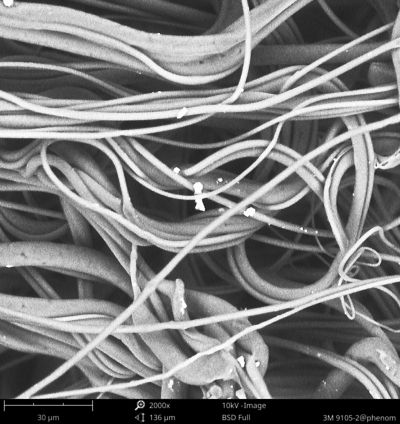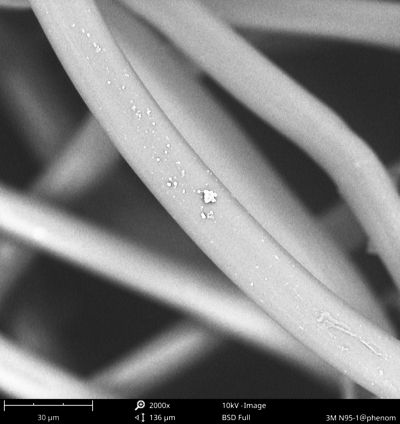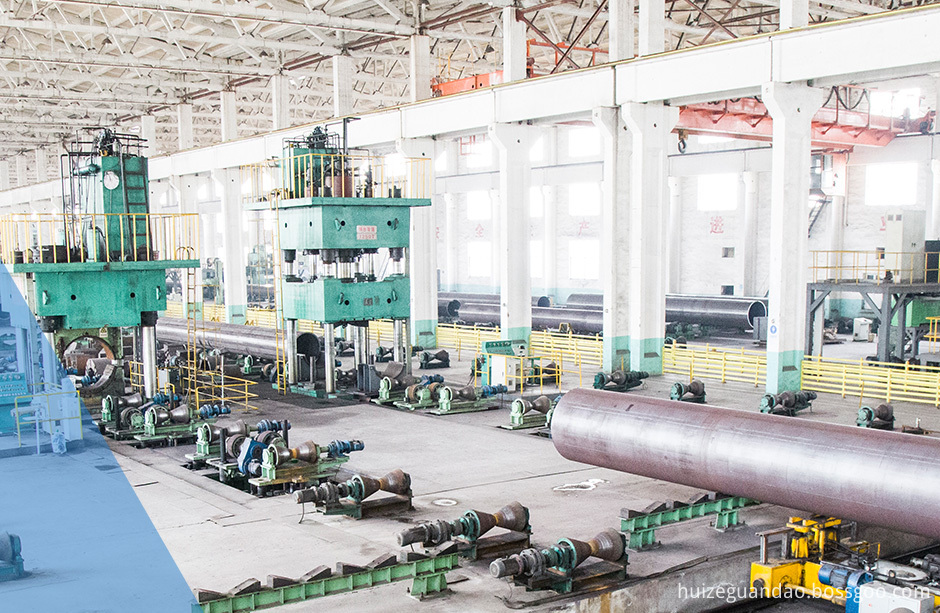
The first layer of mask

The second layer of mask

Mask third layer
Last week's persistent heavy air pollution orange warning became the most interesting topic on the streets. For ordinary citizens, to deal with haze, in addition to reducing outdoor activities, the most direct and simple protective measure is to wear protective masks and take personal protective measures.
However, many people find that white protective masks will turn black after wearing for a few days, making people startle. Does the smog particles already penetrate the protective layer of the mask? Is it that a lot of smog particles have entered the lungs? Recently, the reporter walked into the Polymer Nanocomposite Laboratory at Beijing University of Chemical Technology. Under the electron microscope, the smog particles on protective masks were observed. The reporter found that the key to protective masks lies in the middle layer, which can block nano-scale smog particles. Although the mask has turned black in appearance, the middle layer has not been penetrated by smog particles.
experiment
What are the smog particles on the new mask?
Pm2.5 means that the particle diameter is less than or equal to 2.5 μm, which is invisible to the naked eye. However, under the electron microscope, it is possible to clearly observe the haze particle surface of the haze particle, and the electron microscope energy spectrum integrated machine can not only observe haze particles, but also quickly analyze the composition thereof. According to Liu Yong, an associate professor and doctoral supervisor of Beijing University of Chemical Technology, micron-sized haze particles attached to protective masks can be clearly seen through the magnification of 2,000 times by the electron microscope. The particles are mainly calcium carbonate and iron oxide. Inorganic salts such as sulfate and non-solid aerosols require additional methods for observation.
On the morning of January 6, the reporter wore a brand-new N95 protective mask (model 3M8210), starting from the Yizhuang area of ​​the South Fifth Ring, and arrived at Beijing University of Chemical Technology at the North Third Ring Road. The experimenter broke the mask worn by the reporter, then selected three layers inside and outside the mask at the same position, cut the square of the size of the fingernail, and stuck it on the observation probe of the electron microscope with a special tape. Then put the probe into the chassis. Make observations. After zooming in 2000 times, the reporter saw that the fiber diameter of the first layer of the mask was about 17.2 microns, and the diameter of the smog particles adhering to the mask was about 1.2 microns. Component analysis shows that the particles contain calcium, silicon, carbon and other elements. Liu Yong introduced that calcium may come from sand and silicon may come from dust. The second layer of mask fiber is denser and has smaller pores. After measurement, the second layer of fiber has a diameter of about 1 micron. The reporter saw that there are still some “fish that escape the net†on the fiber. They are smaller and many have reached the nano level. On the third level, the diameter of the mask fiber became thicker, and fewer haze particles reached this layer.
According to Liu Yong, protective masks cannot completely block Pm2.5 particles, but they can block most of them.
experiment
Does the mask become black when it becomes black?
The experimenter also came up with another brand-new N95 mask (3M9901V) that is common in the market to test the protective effect in extreme environments. The experimenter tied the mask to the air inlet of the vacuum cleaner. After half an hour, a round black area appeared on the mask surface. From the naked eye, the second and third layers of masks did not change significantly. According to estimates, vacuum cleaners pump for half an hour is equivalent to people breathing for months or even longer. Under the electron microscope, dense haze particles adhered to the first layer of fiber in the mask, and less haze particles adhered to the second layer of fibers, and fewer particles reached the third layer. The experimental personnel introduced that this shows that most of the haze particles are blocked by masks. The protective effect of the mask is still good, so the mask does not have to worry about the smog particles going through.
Liu Yong introduced that the common protective masks in the market generally consist of three layers. The outermost layer of the masks is microfibers, which can not stop the particles from being too small, but play a shaping role. The middle layer The most compact, can block, adsorb most of the Pm2.5 particles, the third layer is in contact with the skin. He said that the current use of nanofiber respirator on the market is more common, he does not recommend the public to wear respirators like "gas mask", he said that the "gas mask" protective effect is not necessarily better than ordinary protective masks. The effectiveness of protection depends mainly on the efficiency of filtration. The key lies in detection, not how complex the structure is. For the average citizen, the simplest protection method in the haze days is to choose a large-brand, quality-guaranteed mask.
Suggest
Moth-proof mask worn for three days
3M's engineers told reporters that the body of the respirator is made of a particulate filter material that is attached to the body so that the mask can be stably fixed to the head. According to different wearing methods, the fixing band can be designed as a head wear type, an ear band type, or a neck band type, etc., and a certain degree of tightness is required to ensure that the mask is not easily loosened when the head rotates. Metal nose clips can help seal the nose. If it is too soft, it can easily become loose during use and cause leakage. Some masks also have a one-way, exhalation valve that opens only when exhaled. This is to reduce the exhalation resistance and help exhale the hot and humid air exhaled by the body, improving comfort, but the exhalation valve is inhaling. The airtightness must be good enough, and the connection between the exhalation valve and the mask body cannot leak, which needs to be verified by inspection. According to the corresponding certification level, protective masks must meet the required minimum filtration efficiency. For example, a mask that meets China's national standard KN95 level should have a minimum of 95% filtration efficiency for non-oil particles (including particles in smog).
The hermeticity of the protective mask is also very important, because when the mask is worn, the air pollutants that can enter the mask mainly come from the leakage between the mask and the wearer's face. If the protective mask is not suitable for the wearer's face, there is obvious leakage. How high the mask filtering efficiency is, and basically does not provide protection. The airflow will automatically bypass the filter material with high resistance and enter the mask from the leak with the lowest resistance, so that the protection will fail. For consumers, instead of pursuing higher filtering efficiency, it is better to choose a mask that is suitable for oneself and can achieve good closeness to the face with basic protective efficacy. According to 3M engineers, when used masks are often removed, they should be kept dry and hygienic to prevent them from being contaminated or squeezed. The masks can be stored in a clean paper pocket. Repeated use of masks should also pay attention to hygiene, during the removal and re-wear process to avoid contamination of the inside surface of the mask. In addition, for folded masks, if you need to bend the nose clip when saving, you should use a finger pad to bend inside the nose clip to avoid breaking the nose clip or forming a particularly sharp angle. Taking into account various factors, the flood prevention mask can be worn for three days.
Steel Pipe used for conveying fluid pipe, such as oil, natural gas, water, gas, steam, etc.Steel pipe contains two types: seamless steel pipe and welded steel pipe .Steel pipe is one of our mainly produces ,made of carbon steel, stainless steel, alloy steel and other special metal materials as required by its customers.
Our factory has already been certified by the ISO9001-2000 Quality Management System, the Environmental Management System, the Occupational Health and Safety Management System, and American Petroleum Institute (API), and obtained the Special Equipment Manufacturing License of PRC (Security Certificate of Registration of Manufacturing Units of Pressure Pipe Components) issued by the State General Administration of Quality Supervision, Inspection and Quarantine, the Membership Certificate of China Petrochemical Resources Market, the Certificate of Class I Natural Gas Supply Network of China, and the Manufacturing Qualification Certificate of Pressure Pipes for Plants. And in strict accordance with the standards specified in or by the aforementioned, it has established its own scientific QA system and its product quality effectively ensured by its complete quality system and scientific manufacturing processes.
Moreover, our factory has set up its own QC Department and Testing Center equipped with superior devices and capable of X-ray flaw detection, magnetic particle tests, metallographic analysis, chemical tests, mechanical properties tests, impact tests, hydraulic tests, spectroscopic tests, and infrared ray monitoring.
Under the guidance of the [quality-first, reputation-foremost, people-oriented, and technology-based" operating principle, Huize develops rapidly. With its quality products and good services, Huize is eager to cooperate with you sincerely for common development.


Steel Pipe
Steel Pipe,Stainless Steel Pipe,Carbon Steel Pipe,Alloy Steel Pipe
Shijiazhuang Huize Pipe Fitting Co., Ltd. , https://www.huizegd.com